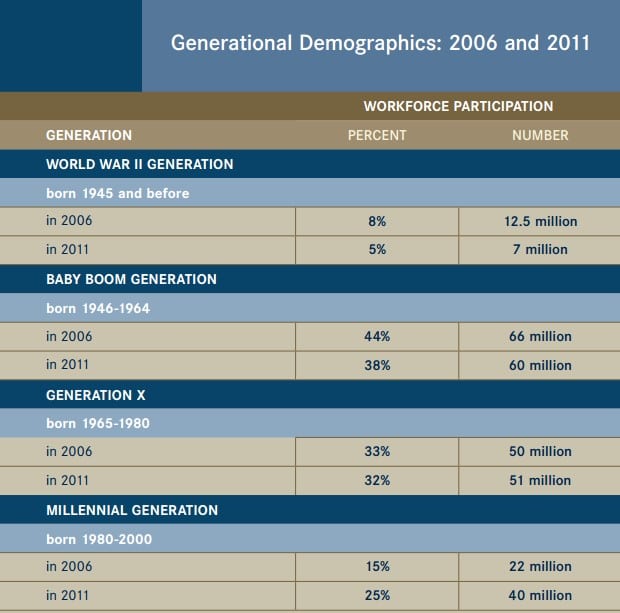For the first time in modern history, workplace demographics now span four generations! Today we see 20-year-old new hires working side-by-side with colleagues who are older than they are by 50 years or more.
This rich mix of generations in the workforce is often attributed to labor shortages experienced in many industries along with the rising average age of retirement. Boomers are also working beyond retirement. One study finds that eight out of ten Baby Boomers expect to work at least part time in their so-called retirement years. [1] In the meantime, the number of Millennials entering the workforce is only growing!

An intergenerational workplace must support real communication and understanding across all ages, and it must understand – and build upon – the unique values and strengths of each generation. Businesses that pay attention to intergenerational issues will see an impact on their bottom line in a number of areas including the following:
Communication: The younger generation has grown up communicating in text messages, tweets, and instant messages. Baby boomers and older Gen Xers tend to prefer phone calls and emails. To further muddle the communication, different generations may use different abbreviations, informal language, and colloquialisms.
Everyone needs to make a concerted effort to communicate in the way each person prefers, especially leaders and employers. Face to face team building exercises and ice breakers may help to break down some of the barriers that can occur with digital communications. [3]
Corporate Culture: Educating employees on generational issues can boost understanding, respect and productivity. One example: younger generations may speak to their employers more casually, which may be interpreted by older generations as lacking respect.
Younger managers and workers may feel that time spent in the office is not as vital as your results and are more open to teleworking. Generation Y may value and expect a more healthy work-life balance, including the time to have a life outside of working. For leaders, it is best to approach the issue by allowing individuals to work in the style that’s best for them and acknowledge the efforts of each team member. [3]
Millennials are the fastest growing cohort, comprising 15 percent of the U.S. workforce.
By 2011, their participation will swell to 25 percent.[2]To recruit and retain them, organizations will need to understand and appeal to their perspectives, communication styles, and work ethic.
Recruitment: Recruitment messages geared to each generation will attract talent across the age spectrum. Targeted recruitment of mature workers gives employers a competitive advantage in acquiring the right talent. At the same time, knowing how to attract younger workers is crucial to ensuring future business success and leadership.
Also be aware of negative stereotypes. “Lazy”, “entitled”, and “tech obsessed”, are just a few of the terms that may come to mind when older workers think about millennials. Baby boomers may be perceived by their younger peers as stubborn, set in their ways, and difficult to train. Leaders can help the situation by looking for and intervening when there is misunderstanding and generational judgment.
Employee Engagement: Managers who know what motivates employees of different generations are more effective in keeping them engaged. Employee satisfaction is higher when they believe that career development opportunities are equal for all, regardless of age.
Also be aware of negative stereotypes. “Lazy”, “entitled”, and “tech obsessed”, are just a few of the terms that may come to mind when older workers think about millennials. Baby boomers may be perceived by their younger peers as stubborn, set in their ways, and difficult to train. Leaders can help the situation by looking for and intervening when there is misunderstanding and generational judgment.

Retention: All generations want their contributions to be recognized. Rewards and recognition should reflect each group preferences and priorities. Employee benefits which are geared to the needs of different generations can build loyalty and retention.
Customer Service: Each generation has unique service preferences. Businesses that understand and adapt to those preferences will attract and retain customers across the age spectrum.
While creating an inter-generational workspace may take more time, customization, and intentionality; there are several benefits to be gained by the whole organization when a multigenerational team works well together.
The team can attract and retain talented people of all ages.
- The team is more flexible.
- The team can gain and maintain greater market share because its members reflect a multi-generation market.
- Decisions are stronger because they’re broad-based with multiple perspectives.
- The team is more innovative and creative.
- The team can meet the needs of a diverse public and can relate more effectively
As employers strive to recruit and retain the best and the brightest, they should look to attract mature workers and young minds with fresh ideas. Both are part of a crucial mix. Combined with recruitment practices, the right combination of policies and practices is also key to a productive, engaged, and “age-neutral” workforce.
If you’re looking for an office space that appeals to multiple generations be sure to explore our many Barrister Executive Suites Office Spaces available throughout Southern California. We offer traditional offices as well as virtual offices to meet your team’s diverse needs. Many of our offices are also located around cultural centers with restaurants, fitness centers, theaters and more to assist you with maintaining a work-life balance that’s right for you.

Learn more about the multi-generational office at http://assets.aarp.org/www.aarp.org_/articles/money/employers/leading_multigenerational_workforce.pdf
[1] AARP, Baby Boomers Envision Retirement II: Survey of Baby Boomers’ Expectations for Retirement (Washington, DC, September 2004), 24.
[2] Bureau of Labor Statistics (see chart)
[3] Fallon, N. (2014, June 16). Tackling the Challenges of the Multigenerational Workforce. Retrieved from Business News Daily: http://www.businessnewsdaily.com/6609-multigenerational-workforce-challenges.html
